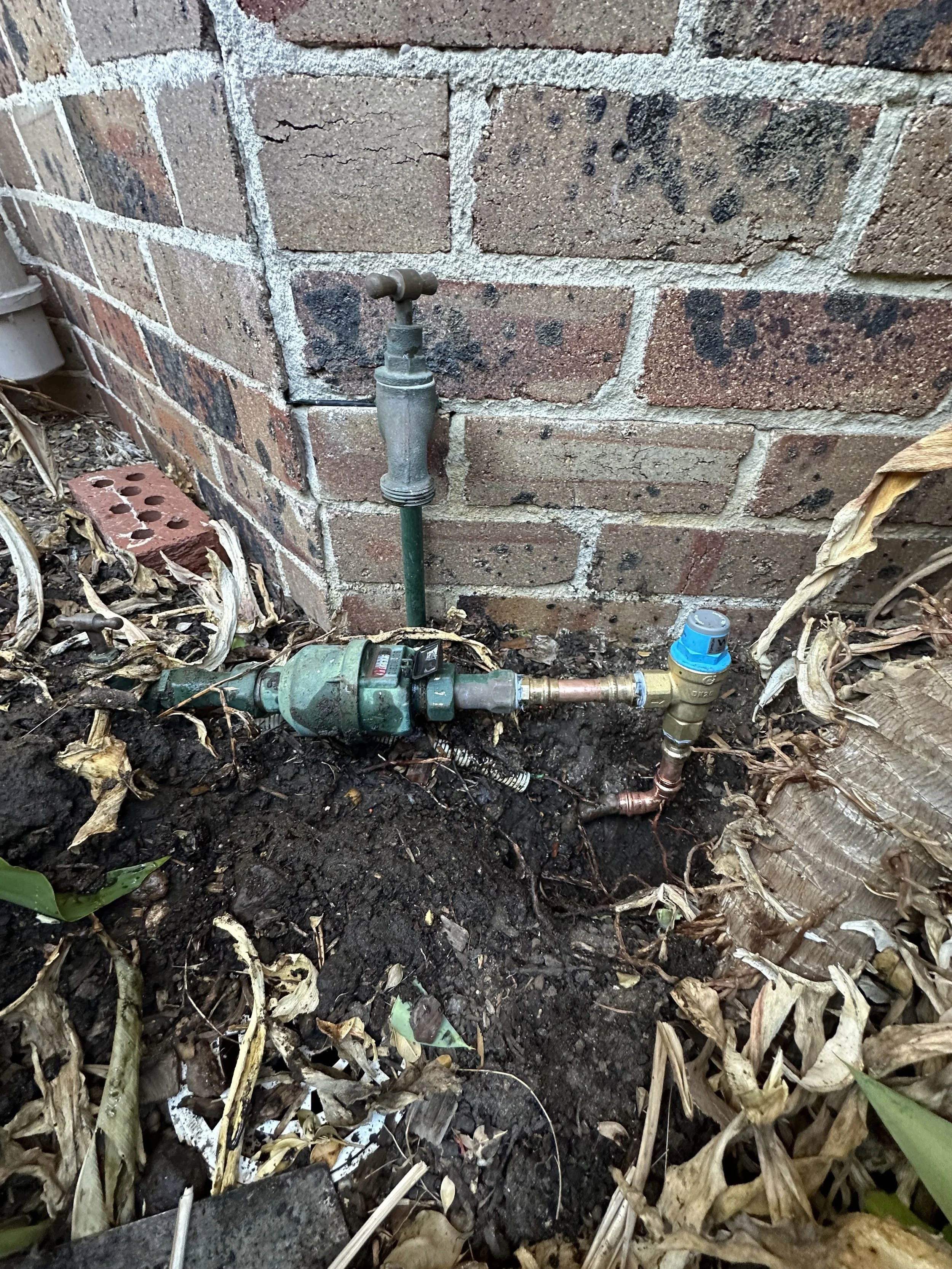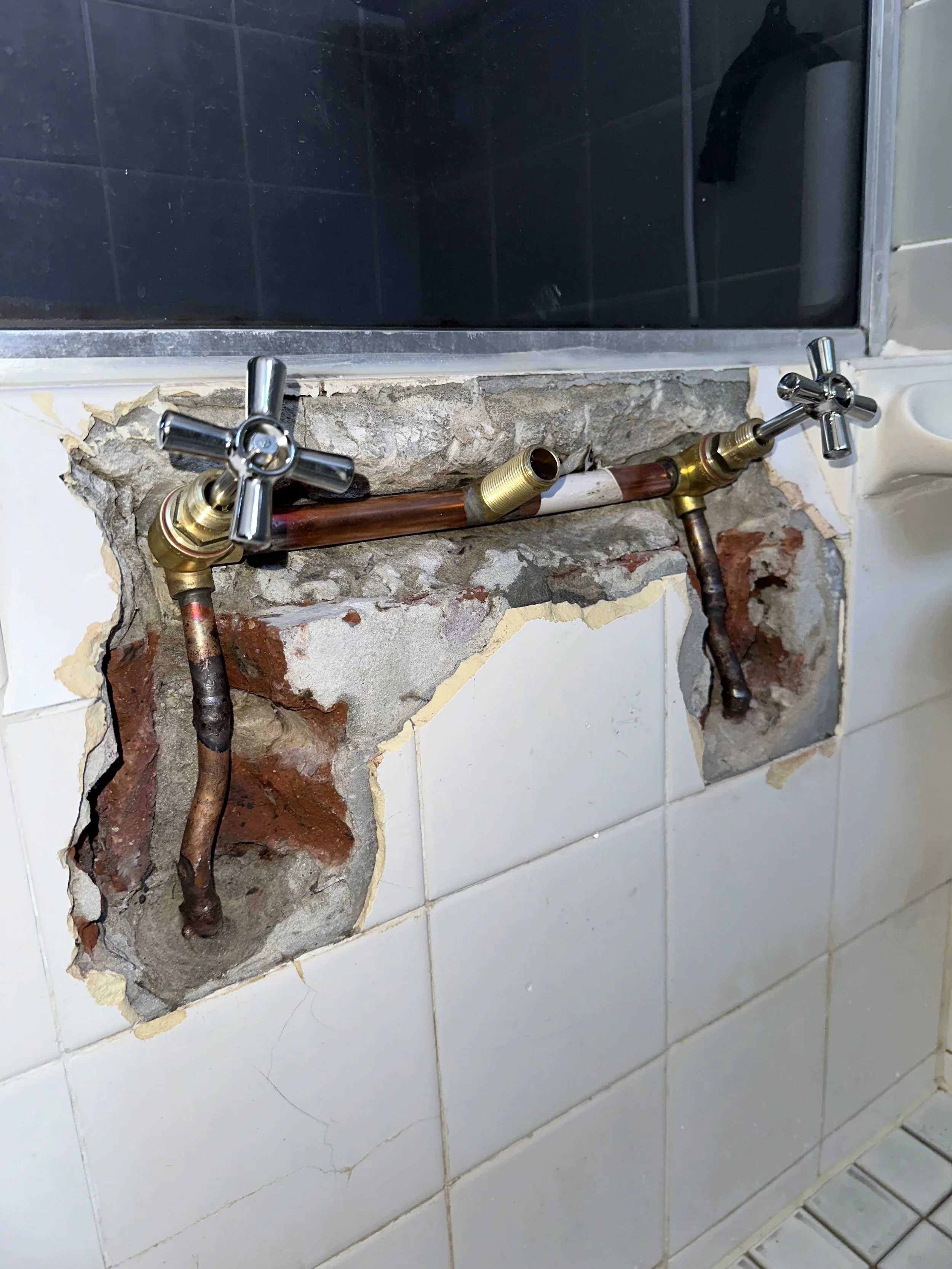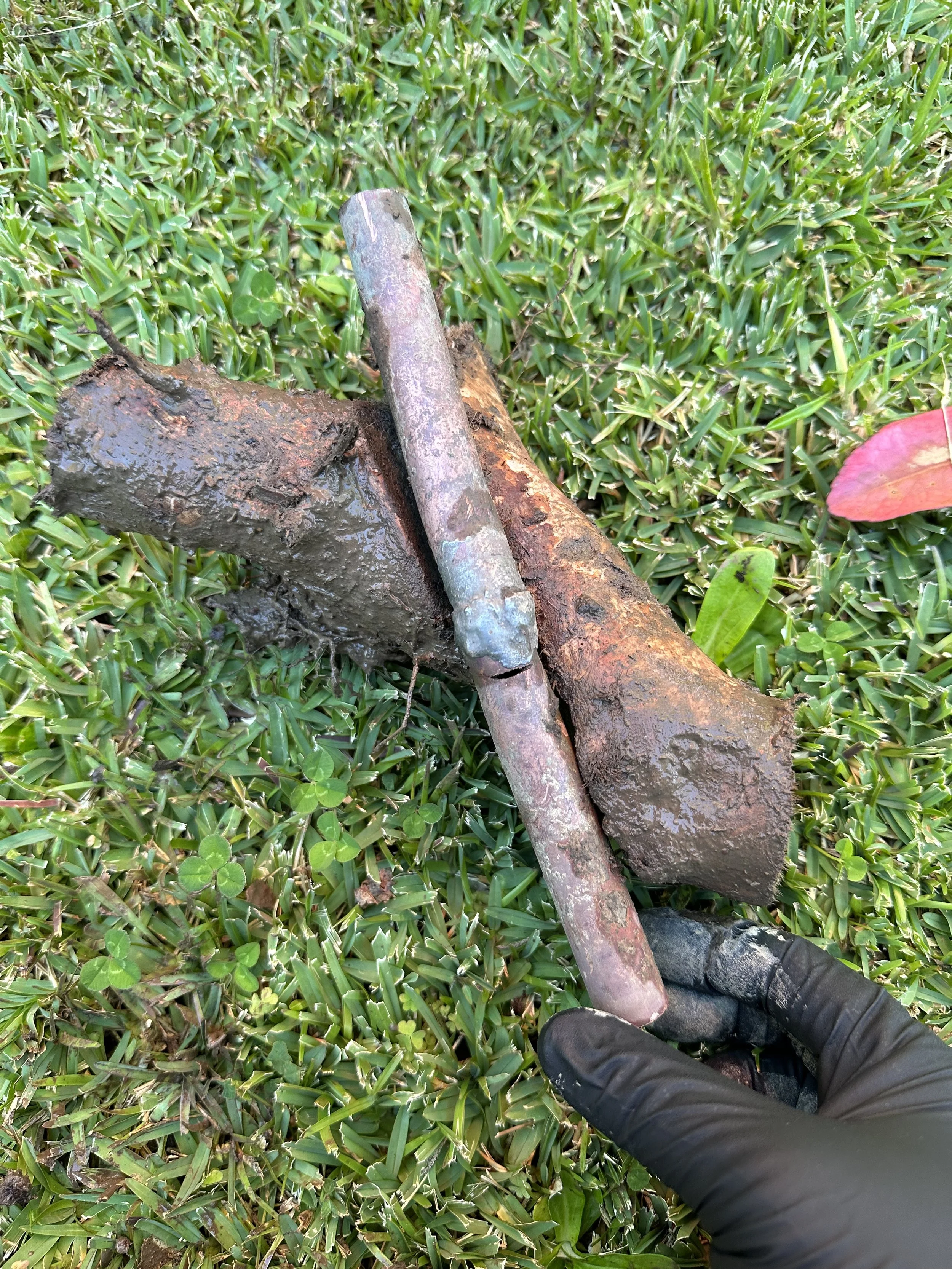Water pipes
-

Burst Flexible Hose
A burst flexible hose is a common yet serious plumbing issue in Australian homes, often leading to significant water damage and costly repairs. These hoses, also known as flexi hoses, are commonly used to connect taps, toilets, and appliances like dishwashers and washing machines to the water supply. While convenient, they are also one of the most frequent causes of internal water damage when they fail.
Common Causes of Burst Flexible Hoses
1. Age & Wear – Over time, the rubber inner lining and stainless steel braid can deteriorate, increasing the risk of failure.
2. Poor Installation – Incorrectly fitted or over-tightened hoses can weaken connections and lead to leaks or bursts.
3. Excessive Water Pressure – High mains water pressure (above 500 kPa) can put stress on the hose, accelerating wear and tear.
4. Corrosion & Rust – Exposure to moisture, chemicals, or cleaning agents can cause the stainless steel braid to corrode, weakening the hose.
5. Lack of Maintenance – Many homeowners overlook the need to regularly inspect and replace flexi hoses before they fail.
6. Kinking or Twisting – Bending the hose too sharply can cause structural weakness, leading to a sudden burst.
How to Prevent Burst Flexible Hoses
• Regular Inspections – Check hoses at least every 6-12 months for signs of wear, rust, or fraying.
• Replace Every 5-10 Years – Even if no visible damage is present, proactive replacement can prevent unexpected failures.
• Install a Pressure Limiting Valve – Ensure household water pressure is kept at a safe level (350–500 kPa) by installing a pressure reducing valve (PRV).
• Use Quality Hoses – Choose WRAS-approved or WaterMark-certified hoses from trusted brands to ensure durability and compliance with Australian standards.
• Turn Off Water When Away – If leaving home for an extended period, turn off the main water supply or isolation valvesto reduce risk.
• Consider Braided Hose Alternatives – In high-risk areas, copper piping or PEX tubing may be a safer long-term solution.
What to Do If a Flexible Hose Bursts?
1. Turn Off the Water Supply – Shut off the nearest isolation valve or turn off the main water supply immediately.
2. Contain the Leak – Use towels or a bucket to minimise water spread and prevent further damage.
3. Contact a Licensed Plumber – A professional can assess the damage, replace the hose, and check for any underlying plumbing issues.
4. Check for Water Damage – Inspect surrounding areas for potential structural damage, mould growth, or electrical hazards.
Australian Standards & Compliance
• Ensure flexible hoses meet AS/NZS 3499 for flexible connectors.
• Install in accordance with AS/NZS 3500.1 for water supply plumbing.
• Many insurance policies do not cover damage from burst hoses if regular maintenance has not been conducted, so check your policy terms.
Popular Brands in Australia
Reliable flexible hose brands in Australia include RMC, AVG, Apex, Fix-a-Tap, and Rehau.
Final Advice
Burst flexible hoses are a leading cause of internal water damage in Australian homes, but with regular inspections, quality replacements, and pressure control, the risk can be significantly reduced. Don’t wait for a failure—proactive maintenance is key to preventing costly water damage.
-

Pressure Reducing Valve on Water Meter
A pressure reducing valve (PRV) is an essential plumbing device used in Australian homes and commercial buildings to regulate and control water pressure from the mains supply. It ensures that water flows at a safe and consistent pressure, preventing damage to pipes, fixtures, and appliances.
Key Features & Benefits
1. Protects Plumbing & Appliances – Reduces excessive water pressure, preventing leaks, burst pipes, and damage to hot water systems, taps, and dishwashers.
2. Improves Water Efficiency – Helps conserve water by preventing unnecessary wastage due to high-pressure flow.
3. Consistent Water Pressure – Provides stable pressure levels, reducing fluctuations that can affect showers and taps.
4. Extends the Lifespan of Fixtures – Protects taps, toilets, washing machines, and irrigation systems from excessive wear and tear.
5. Required for Certain Hot Water Systems – Many instantaneous gas and solar hot water systems require a PRV to function correctly and maintain warranty compliance.
How Does a Pressure Reducing Valve Work?
• The PRV is installed on the main water supply line, typically near the water meter.
• It contains a spring-loaded diaphragm that adjusts to reduce high mains pressure to a preset, safe level (usually between 350–500 kPa for residential use).
• As water flows through the valve, the internal mechanism regulates pressure to prevent excessive force from reaching household plumbing.
Installation Considerations
• Mains Water Pressure Check – Before installation, a licensed plumber should test the incoming mains pressure (ideal range: 350–500 kPa for most homes).
• Hot Water System Compliance – Some water heaters, including instantaneous gas, solar, and heat pump systems, require PRVs to meet warranty and operational standards.
• Pipe Compatibility – Available in different sizes (15mm, 20mm, 25mm, etc.) to suit various plumbing configurations.
Popular Brands in Australia
Common PRV brands available in Australia include RMC, AVG, Reliance, Wilkins, and Apollo.
Do You Need a Pressure Reducing Valve?
A pressure reducing valve is a smart investment for Australian homes and businesses, particularly in areas with high mains water pressure. It helps protect plumbing systems, improve water efficiency, and extend the life of household appliances. Always consult a licensed plumber to determine if a PRV is necessary for your property.
-

Repaired Shower Breech
Repaired Shower Breech in Australia
A shower breech is a key component of a shower’s plumbing system, located behind the wall where the hot and cold water pipes meet at the mixer or taps. Over time, shower breeches can develop leaks, cracks, or corrosion, leading to water damage inside the wall cavity. A repaired shower breech ensures that the plumbing remains watertight, preventing costly damage and maintaining proper water flow.
Common Causes of a Faulty Shower Breech
1. Age & Corrosion – Older homes may have copper or brass breeches that corrode over time, leading to leaks.
2. Poor Installation – Incorrectly soldered or fitted connections can weaken and cause leaks.
3. Water Pressure Issues – Excessive mains pressure (above 500 kPa) can put strain on fittings and joints.
4. Movement in Walls – Structural movement, renovations, or shifting pipes can cause cracks in soldered joints.
5. Worn-Out Tap Washers or Mixer Seals – A leak at the tap or mixer can indicate deeper issues within the breech.
Signs That a Shower Breech Needs Repair
• Water Leaks Behind the Wall – Damp patches, bubbling paint, or mould on the wall or ceiling below the shower.
• Reduced Water Pressure – Leaks in the breech can lower water pressure at the showerhead.
• Unexplained Water Bills – A hidden leak can increase water usage over time.
• Dripping Taps or Mixer Issues – Even with new washers, ongoing leaks may indicate a failing breech.
Shower Breech Repair Process
1. Inspection & Leak Detection – A licensed plumber will assess the breech, often using a moisture meter or pressure test.
2. Accessing the Breech – The repair may require removing tiles or cutting into the wall behind the shower.
3. Replacing or Repairing the Breech – Options include re-soldering, replacing copper fittings, or upgrading to a modern brass.
4. Sealing & Waterproofing – After repairs, the area is resealed to prevent further moisture issues.
5. Pressure Testing – Ensuring the system is leak-free before closing up the wall.
Installation Considerations
• Ensure Compliance – Repairs must meet AS/NZS 3500.1 Plumbing and Drainage standards.
• Waterproofing – Proper sealing and waterproofing of the shower recess prevent long-term structural damage.
• Check Water Pressure – Installing a pressure-limiting valve (PLV) can protect the breech from excessive pressure.
-

Burst Water Pipe
A burst copper pipe in the ground is a serious plumbing issue that can lead to water wastage, property damage, and costly repairs. In Australia, copper pipes are commonly used for underground water supply lines due to their durability, but they can still fail over time due to corrosion, soil movement, or high water pressure.
Common Causes of a Burst Underground Copper Pipe
1. Corrosion & Electrolysis – Over time, chemical reactions in the soil can cause the copper pipe to corrode, leading to pinhole leaks or full bursts.
2. Soil Movement & Tree Roots – Shifting ground, nearby tree roots, or heavy traffic above the pipe can cause fractures or cracks.
3. Poor Installation – Improperly joined or soldered pipes can develop weak points that fail over time.
Signs of a Burst Copper Pipe in the Ground
• Unexpectedly High Water Bills – A sudden increase in usage without any change in household water consumption.
• Water Pooling or Damp Soil – Wet or soggy patches in the garden or lawn, even in dry weather.
• Loss of Water Pressure – Weak water flow from taps or showers due to water escaping underground.
• Hissing or Running Water Sounds – Unusual sounds coming from the ground, especially near main water pipes.
• Discoloured Water – Brown or rusty water from taps can indicate dirt entering the system through a damaged pipe.
Repairing a Burst Underground Copper Pipe
1. Locate the Leak – A licensed plumber may use acoustic leak detection, thermal imaging, or pressure testing to pinpoint the burst pipe.
2. Excavation – The affected section of the pipe must be dug up carefully to access the damaged area.
3. Pipe Repair or Replacement – Depending on the extent of the damage, the plumber may cut out the damaged section and replace it with new copper or PEX piping.
4. Refilling & Restoration – The soil is compacted, and any landscaping, paving, or driveways affected are restored.
Preventing Future Underground Pipe Bursts
• Install a Pressure Limiting Valve (PLV) – Keeps household water pressure within a safe range (350–500 kPa).
• Avoid Planting Large Trees Near Water Lines – Tree roots can wrap around pipes, leading to cracks and bursts.
-

Pool Copper Shower
A pool copper shower is a popular outdoor shower choice in Australia, offering a durable, stylish, and weather-resistantsolution for rinsing off before or after swimming. Copper is a high-quality, corrosion-resistant metal that develops a natural patina over time, giving it a unique and rustic aesthetic that complements modern, coastal, and tropical outdoor settings.
Key Features & Benefits
1. Durable & Weather-Resistant – Copper is naturally corrosion-resistant, making it ideal for outdoor showers exposed to the elements.
2. Stylish & Timeless Look – Over time, copper develops a beautiful patina, transitioning from shiny bronze to earthy greens and blues.
3. Low Maintenance – Requires minimal upkeep; occasional polishing can maintain its original shine, or it can be left to patina naturally.
4. Eco-Friendly & Sustainable – Copper is a recyclable material and offers excellent longevity compared to plastic or stainless steel alternatives.
5. Hot & Cold Water Compatibility – Can be connected to both hot and cold water lines, making it versatile for year-round use.
6. Great for Pool & Beach Homes – Ideal for rinsing off chlorine, saltwater, and sand, helping to keep the pool and home clean.
Installation Considerations
• Water Supply Connection – Can be plumbed into an existing water line or installed with a freestanding hose connectionfor flexibility.
• Drainage Planning – Ensure proper drainage or soak-away systems to prevent water pooling around the shower area.
• Wall-Mounted vs. Freestanding – Choose between a fixed wall-mounted setup or a standalone shower post, depending on space and design preference.
• Location & Sun Exposure – Install in a sunny spot to maximise warmth, especially if using a solar-heated system.
Maintenance Tips for a Copper Outdoor Shower
• Allow Natural Patina or Polish for Shine – If you prefer the aged look, let the copper naturally oxidise. To maintain shine, use a copper cleaner or lemon and salt mix.
• Check for Mineral Build-Up – If using bore water or hard water, occasional descaling may be required.
• Protect from Extreme Conditions – While copper is durable, consider insulating exposed pipes in areas prone to extreme cold.
Popular Brands & Custom Options in Australia
Australian suppliers offer custom copper showers from brands such as ABI Interiors, Wood Melbourne, Copper Co, and custom metal fabricators. Some showers even feature rainfall showerheads, foot rinsers, and minimalist designs to suit modern outdoor aesthetics.
Final Advice
A pool copper shower is a practical, durable, and stylish addition to any Australian backyard, offering aesthetic appeal and long-term functionality. Whether installed near a swimming pool, beach house, or garden retreat, it provides a refreshing rinse-off experience while enhancing outdoor living spaces.
-

Added Additional Garden Tap
Added Additional Garden Tap to the side of the house.
